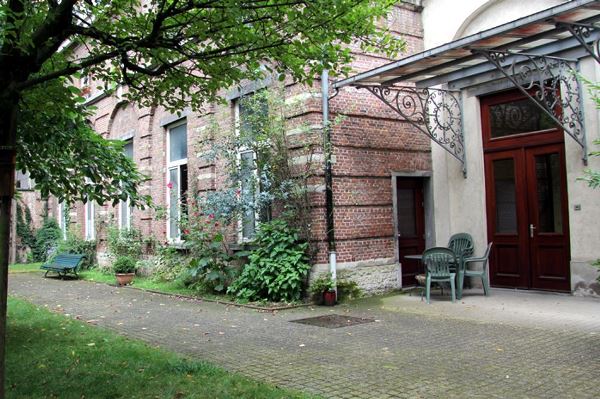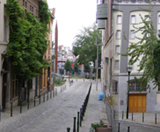Summary, abstract and full texts n° 100
Philippe Mesnard, Yannis Thanassekos: Témoigner. Entre Histoire et Mémoire. Revue pluridisciplinaire de la Fondation Auschwitz (pdf in French)(pdf in Dutch)
Dossier: Questions de « bourreaux »
Coordinated by Philippe Mesnard and Yannis Thanassekos
Philippe Mesnard: Editorial(pdf in French)(pdf in Dutch)
Benoît Cazenave: La Mégère de l’Armagedon (pdf)
- After 1945, Ilse Koch was indicted for numerous crimes committed against the prisoners of KZ. She was further accused, albeit without proof, of numerous other crimes including the creation of objects made with human skin and sexual deprivation, and in the context of the Cold War and denazification her trials became symbols of german democratisation and exoneration, and of the feminisation of nazi ignominy. After having served as a muse for numerous works of sado-eroticism and nazi fascination in the 1960s and 1970s, she remains a reference point in "feminine violence" and an instrument of negationist propaganda.
Regula Christina Zürcher: Massacreur et père : un paradoxe apparent (pdf) [Parent and mass-murderer: an apparent paradox with a system]
-
Parent and mass-murderer - an apparent paradox with a system Using the records of the Auschwitz Kommandantur, the memoirs of SS personnel and their trial statements, descriptions by prisoners and the research carried out to date, this article describes the family life of the SS members who ran the mass killing installations at Auschwitz. It shows that the presence of their wives and children was essential for enabling the SS and the murder machine to function The families, who lived a pleasant and varied life in the SS quarters, provided the criminals with distractions and rewards which enabled them to forget their "work" of killing and believe that their activities were normal.Using the records of the Auschwitz Kommandantur, the memoirs of SS personnel and their trial statements, descriptions by prisoners and the research carried out to date, this article describes the family life of the SS members who ran the mass killing installations at Auschwitz. It shows that the presence of their wives and children was essential for enabling the SS and the murder machine to function. The families, who lived a pleasant and varied life in the SS quarters, provided the criminals with distractions and rewards which enabled them to forget their "work" of killing and believe that their activities were normal.
Régine Waintrater: Les Bienveillantes, intimité forcée ou intimidation ? (pdf)
- Jonathan Littell's novel, Les Bienveillantes [The Kindly Ones] is based on a strategy emanating from its author and functioning within the text itself as a means of perverse seduction. To this effect, both the author and Max Aue's story (Aue is the main character as well as the narrator, who relates his life as a member of the SS at the Eastern Front, in Berlin and in the Nazi camps) make profuse use of entanglements of extreme violence, sexual aberration and transgressive scenes. The paradox is that this novel has been celebrated as a new breakthrough in the discovery of the mechanisms of the Shoah through the prism of a perpetrator's mind, while major investigations on the real individuals guilty of such crimes reveal that this character lacks all plausibility. The actual perpetrators remain silent, but this one is a great talker.
Charlotte Lacoste: De la vigilance critique (pdf)
- Jonathan Littell's novel was widely acclaimed by the French critics, and many of them did consider the book as the first literary masterpiece of the 21st. century. Aware that Les Bienveillantes did not distinguish itself by its literary qualities, the critics generally advanced two arguments to justify their craze: the documentary work on the one hand, and the narrative device on the other hand. This article intends to deliver a critical analysis of textual devices used in Les Bienveillantes and to enlighten the intertexts to which the author resorts and the strategies of seduction he displays towards the public in order to darken the understanding of the Shoah.
Pierre Ayçoberry: Autoportrait d’un fanatique en quarante mille pages : le Journal de Joseph Goebbels 1923-1945
-
Goebbels kept a daily journal for twenty two years in which he noted the day's activities, and remarks made by his friends, enemies, and master. Following half a century of unexpected disappearances and reappearances of partial or erroneous versions of the journals, a definitive 29 volume edition was finally published between 1993 and 2005 thanks to the perseverance of the members of the Munich Institut für Zeitsgeschichte. An abridged French edition in four volumes is in progress, of which the first three installations have already been published.
The volume of information that these pages provide on the internal workings of the Party, and subsequently the Nazi regime, clearly needs to be approached critically and not simply taken at face value. The very nature of the manuscript (a personal diary) implies that the author presents himself to posterity as consistently being the most lucid and faithful of the Führer's acolytes on both good days and bad.
It is precisely this professed fidelity which guarantees that he transcribed both Hitler's rages and his rational analyses with the same scrupulous care. The reader is thus able to study two fanatics, almost inseparable from their first to their last encounter.
Pierre Thys: Approche criminologique du criminel de guerre contemporain (pdf)
- Through the medium of illustrative cases drawn from contemporary armed conflicts it becomes possible to study "executioners" by taking recourse to criminology, and more particularly to criminal psycho-sociology. The war criminal could very well vary only in degree, and not in nature, to the criminal of common law. He certainly seems more "normal" than the socially disengaged criminal, but this difference becomes less clearly defined as soon as the process leading up to the crime and permitting its repetition is placed under closer scrutiny. We can thus show that the war criminal can certainly benefit from criminology in order to explain actions and their genesis. Whilst the criminal’s convictions take primacy, the crime itself, whether motivated by opportunism, profit, or ideology, remains a crime without glory, and he who commits it a criminal conscious of his actions.
Laurent Thiery: La « Gestapo de Lille » (1940-1944) : histoire et représentation
- Between 1940 and 1944 a branch of the Sipo-SD operated in Lille against the Jews and the Resistance, under the supervision of OFK 670. Although it had few staff and was largely subordinate to the army, the "Gestapo of Lille" came to epitomise the image of the Nazi torturer in post-war collective memory. This image is examined through a study of these men and their work.
- Even though the Auffanglager in Breendonk and the Polizeiliches Durchgangslager in Amersfoort differ in several aspects (among which are the small size of the first and the fact that the second also served as a training camp for young SS recruits), they have in common that they both used autochthonous as well as German guards. It is hence possible to draw comparisons regarding the evolution of their respective staffs during the conflict (division of tasks, number ...) and with respect to the - often violent - methods which were used.
Moreover, the main "perpetrators" of both camps were brought to trial and it is quite interesting to compare the procedures and the sentences pronounced, as well as to establish parallels between the reactions of public opinion in each of the two countries involved.
Frediano Sessi: Criminels par procuration ? Sur l'auto-administration des détenus dans les Lager (pdf) [Criminals by proxy? Prisoner self-government in the camps and delegation of power by the SS]
- The delegation of power to those prisoners whom Himmler in a summer 1944 speech called the army of "my non-commissioned officers" began in 1933 at Dachau with the appointment of an barrack assistant (Feldwebel) and an assistant for the work brigade (Arbeitsfeldwebel). During this period the prisoners delegated with powers of organization and punishment were German criminals.
Subsequently prisoner accomplices were chosen according to the organisational system of the camp, which was divided into five departments (six from 1942) and gave rise to such figures as the Lagerälteste (the camp’s chief prisoner), the Blockälteste (the head of a block), Stubenälteste or Stubendienste (servants in the barracks) and the kapos (responsible for a work brigade) or deputy kapos, not forgetting the army of Schreiber who kept the archives up to date, or the interpreters (Interpreten), the messagers (Läufer), the kitchen kapos (prisoners in charge of the kitchens) or the nursing staff in the Revier. The prisoners in the special brigades who worked in the crematoria and gas chambers in the extermination camps (Sonderkommando) deserve a section to themselves. To quote Rousset, these prisoners formed the camp aristocracy. And yet they included not only cruel collaborators and killers, but members of the resistance who struggled to save many of their comrades, as shown by the example of the "protective militia" formed by the red triangle kapos in Buchenwald. Many acts of resistance by privileged prisoners (known by the general term of kapo) are still little known today, and there is as yet no account of the system in the Nazi camps which describes the full complexity of the structure of society in the camps, using also the testimony of kapos.
Other subjects
Susanne Wein: Antisémitisme dans les mouvements ouvriers des années 1920 ? Enquête sur la presse ouvrière de Brême de 1924 à 1928
-
This article examines the previously neglected issue of the attitude of the left, specifically the KPD and SPD in Bremen, when confronted with anti-Semitism. The work is based on the theory that after the Empire, anti-Semitism became a universal cultural code used in interpreting the world and society as a whole.
After reviewing the common history of the socialist parties until the First World War, the article focuses on selected specific anti-Semitic events that took place in Bremen during the Weimar Republic.
In order to deduce contemporary attitudes the author has chosen to analyse the left wing parties' daily newspapers dating from the relatively calm period from 1924 to 1928. Trends and patterns are illustrated that permit an analysis that goes beyond Bremen. In its perpetuation of a manichaen world-view the KPD demonstrated a structural tendency not only to not recognise anti-Semitic themes but also to produce them themselves. This always occurred through the evocation of the "rich Jewish capitalist". In conjunction with this image the papers peddled conspiracy theories in which their clientele were stylised as victims. The party line of not distinguishing between Jewish and Christian capital was constantly contradicted in practice. In the SPD, the cultural convention of anti-Semitism was also manifest. The party was certainly scandalised by anti-Semitic messages and activity, but unpremeditated themes appeared. The SPD evoked the ironic stereotype of "typically Jewish" against their right-wing adversaries, without recognising the underlying implications of using the image. According to party rhetoric, Jews had to remain beyond reproach. In reality, the SPD didn't hesitate to use anti-Semitic images.
Chris Gastmans, Maria Berghs & Bernadette Dierckx de Casterlé: Verantwoordelijkheidspraktijken en verpleegkundigen gedurende de euthanasieprogramma’s van Nazi-Duitsland (1939-1945)
- The present article examines the context of the moral decisions made by nurses working within the euthanasia programme of Nazi Germany between 1939 and 1945. Our reference frame is Margaret Urban Walker's philosophical model, and especially the hypothesis according to which morality consists of a set of responsible practices. In this way, we try to map how nurses conceived their own responsibilities in the euthanasia programme. First, we will sketch the euthanasia programme in Nazi Germany between 1939 and 1945 and the part nurses played in it. This outline will show how the nurses' responsibilities have been manipulated. Subsequently, we will study nursing as a moral practice in the specific context of the euthanasia programme's ideas and practices regarding responsibility. In the third place, we will examine the reasons wich were offered by the nurses to escape all responsability. Fourthly, we will try to determine whether nurses bore indeed some responsibility in the euthanasia programme. In conclusion, we will discuss the historical pertinence of an ethical reflection on the moral responsibility of nurses who are nowadays confronted with euthanasia.
Hélène Piralian: En quoi le génocide met-il à l'épreuve les fondements mêmes de la psychanalyse ? Les sites rwandais
Some of our projects
Contact
Auschwitz Foundation – Remembrance of Auschwitz
Rue aux Laines 17 box 50 – B-1000 Brussels +32 (0)2 512 79 98
+32 (0)2 512 79 98 info@auschwitz.be
info@auschwitz.be
BCE/KBO Auschwitz Foundation: 0876787354
BCE/KBO Remembrance of Auschwitz: 0420667323
Office open from Monday to Friday 9:30am to 4:30pm.
Visit only by appointment.
![]()
![]()
![]()
![]()
![]()
Become a member
To become a member of Remembrance of Auschwitz ASBL, please contact us and transfer the sum of €50.00 to our account IBAN: BE55 3100 7805 1744 – BIC: BBRUBEBB with the communication: ‘Membership fee 2025’. The membership includes two issues of 2025 of our scientific journal.
DONATIONS
Donations of €40.00 or more (in one or more instalments) qualify for tax exemption for Belgian taxpayers.
In communication, please specify that it is a ‘Donation’ and mention your National Number which is required since 2024 to benefit from the tax exemption.
Subscribe
Error : Please select some lists in your AcyMailing module configuration for the field "Automatically subscribe to" and make sure the selected lists are enabled










 The Auschwitz Foundation was founded in 1980 by Paul Halter, an Auschwitz survivor. Replacing the Amicale Belge des Ex-Prisonniers politiques d’Auschwitz-Birkenau Camps et Prisons de Silésie, the primary objective of the Auschwitz Foundation is to study the history and memory of the victims of the Holocaust and the Nazi terror in a sustainable and systematic way. The transmission of memory and the preservation of archives concerning these events complete this goal.
The Auschwitz Foundation was founded in 1980 by Paul Halter, an Auschwitz survivor. Replacing the Amicale Belge des Ex-Prisonniers politiques d’Auschwitz-Birkenau Camps et Prisons de Silésie, the primary objective of the Auschwitz Foundation is to study the history and memory of the victims of the Holocaust and the Nazi terror in a sustainable and systematic way. The transmission of memory and the preservation of archives concerning these events complete this goal.





